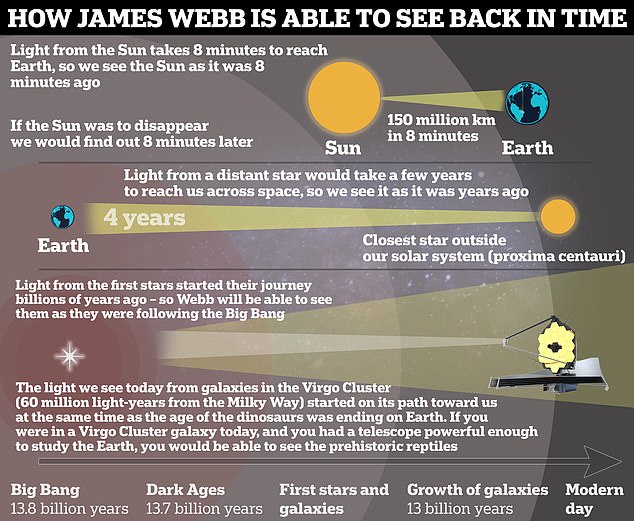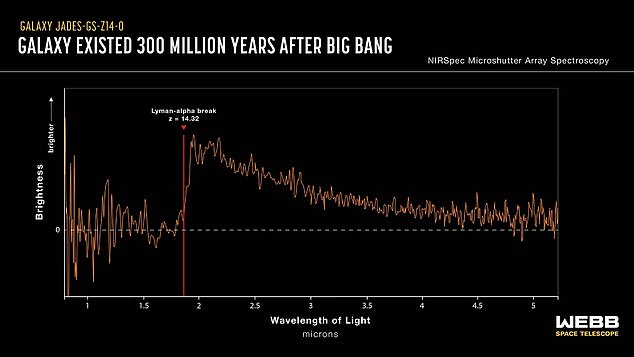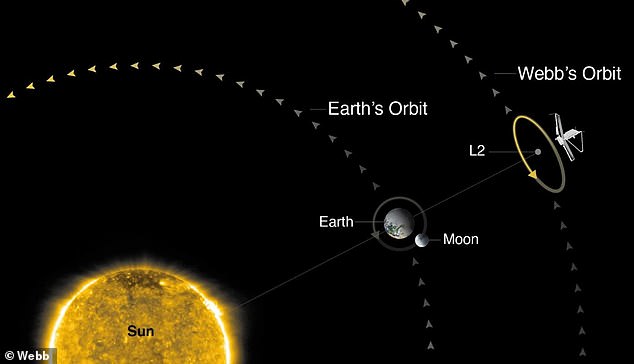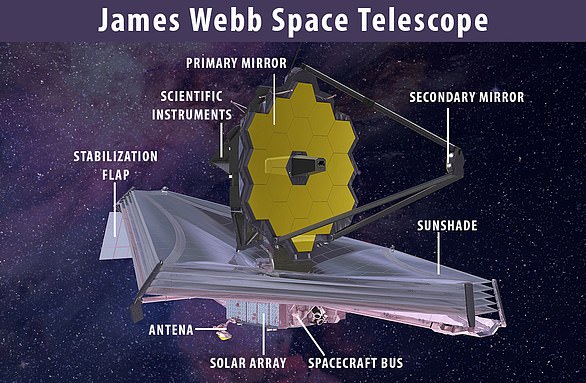A window into the cosmic dawn: NASA’s James Webb telescope finds the most distant galaxy in the universe that existed just 300 million years after the Big Bang
NASA’s James Webb Telescope has found the most distant galaxy in the universe.
The light from the galaxy, called JADES-GS-z14-0, took about 13.5 billion years to reach us – meaning the light began its journey just 300 million years after the Big Bang.
The newly discovered galaxy is 1,600 light-years across, meaning it takes light 1,600 years to travel from one end to the other.
Experts say JADES-GS-z14-0 is ‘remarkable for how big and bright it is’, with vast amounts of light being produced by its young stars.
The $10 billion telescope – which can ‘look back in time’ – has also found the second most distant galaxy in the universe, called JADES-GS-z14-1.
Using NASA/ESA/CSA’s James Webb Space Telescope, scientists have found a record-breaking galaxy observed just 300 million years after the Big Bang
“This discovery is completely unexpected and will likely be regarded as the most important extragalactic discovery with JWST to date,” said Brant Robertson, an astronomer at the University of California, Santa Cruz, co-author of a new study.
“This galaxy is truly a gem and points to even more hidden treasures in the early universe.”
The James Webb telescope is often said to be able to “see back in time,” and while it sounds fantastic, it’s really true.
Because the universe is so vast, it can take billions of years for light from one galaxy to reach another.
When light from a distant galaxy finally reaches us, the light reveals a “snapshot” of the galaxy as it looked when it began its journey billions of years ago.
In this case, the light from JADES-GS-z14-0 – newly detected by the James Webb telescope – began its journey about 13.5 billion years ago, said co-author Francesco D’Eugenio, an astrophysicist at the University of Cambridge, to MailOnline.
At the time, the distance between JADES-GS-z14-0 and the time when our galaxy (the Milky Way) would eventually form was only 2 billion light-years.

Webb’s infrared capabilities allow him to “look back in time” to the Big Bang, which occurred 13.8 billion years ago. Light waves move extremely fast, about 186,000 miles (300,000 km) per second, every second. The further away an object is, the further back in time we look. This is due to the time it takes for light to travel from the object to us
But because the universe has expanded enormously since then, the distance between JADES-GS-z14-0 is now more than 34 billion years.
By the time light from the most distant galaxies reaches Earth, it has been stretched by the expansion of the universe and shifted into the infrared region of the light spectrum, which Webb can detect with unprecedented clarity.
Astronomers first spotted JADES-GS-z14-0 in early 2023, but they needed further observations to be sure it was truly a record-breaker and not a “confusing oddity.”
JADES-GS-z14-0 comfortably beats the previous record for the oldest known galaxy, held by JADES-GS-z13-0, which was present 320 million years after the Big Bang.

Galaxy JADES-GS-z14-0 existed only 300 million years after the Big Bang (which occurred about 13.8 billion years ago)

The James Webb Space Telescope orbits the sun, 1 million miles from Earth, at what is called the second Lagrange point, or L2
For the past two years, scientists have used James Webb to investigate what astronomers call “cosmic dawn”: the period in the first few hundred million years after the Big Bang when the first galaxies were born.
These galaxies provide vital insight into the ways the gas, stars and black holes changed when the universe was very young
Since coming online in 2022, the Webb Telescope has ushered in a new era of scientific breakthroughs, peering further into the far reaches of the universe than ever before.

